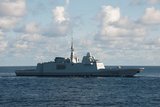Harris introduces new power amplifier for Falcon III
Harris Corporation has introduced a new power amplifier that provides greater capacity, efficiency and range to wideband tactical networking. The UL-Band amplifier will serve as an accessory to the Falcon III AN/PRC-117G and offers the same size, weight and power profile as the existing VHF/UHF amplifier.
The company has developed the amplifier to work with the Falcon III AN/PRC-117G to provide continuous UHF and L-Band frequency coverage from 225 MHz to 2 GHz. It will help to overcome challenges posed by the high concentration of data transmissions in the 225 to 450 MHz range, which results in a reduced spectrum available in this frequency band.
According to the company, the extended frequency coverage provided by the new power amplifier allows users operating in vehicles to take advantage of the additional spectrum available up to 2 GHz to send and receive large data files, including video. The power amplifier is compatible with legacy narrowband waveforms as well as various wideband waveforms such as the Wideband Networking Waveform, Soldier Radio Waveform, Mobile User Objective System and Adaptive Networking Wideband Waveform. Harris successfully operated the new power amplifier on military vehicles at the recently completed US Army Network Integration Evaluation (NIE).
George Helm, president, Department of Defense business, Harris RF Communications, said: ‘Our UL-Band power amplifier provided soldiers at the NIE with significant performance enhancements in the wideband network. In particular, the amplifier enabled our solution to meet or exceed requirements for voice and data in range, throughput, security and reliability. The UL-Band amplifier provides increased overall capacity and offers the army a robust Wideband Networking Waveform-based solution.’
The AN/PRC-117G is a JTRS-Certified radio, combining line-of-sight, beyond-line-of-sight and wideband communications capabilities in a single lightweight package. The radio provides enhanced situational awareness of the battlefield by connecting warfighters to the tactical Internet.
More from Digital Battlespace
-
![Babcock nears first customer for Nomad AI translation tool]()
Babcock nears first customer for Nomad AI translation tool
Nomad can provide militaries with real-time intelligence, saving critical time on the battlefield.
-
![AUSA 2025: Israel’s Asio Technologies to supply hundreds of improved Taurus tactical systems]()
AUSA 2025: Israel’s Asio Technologies to supply hundreds of improved Taurus tactical systems
Taurus operates alongside the Israel Defense Forces’ Orion system which supports mission management across tens of thousands of manoeuvring forces, from squad leaders to battalion commanders.
-
![AUSA 2025: Kopin pushes micro-LED plans as China moves faster]()
AUSA 2025: Kopin pushes micro-LED plans as China moves faster
The plan for the new displays follows fresh investment in Kopin’s European facilities by Theon and an order for head-up displays in fielded aircraft, with funding from the US Department of Defense.
-
![AUSA 2025: Persistent Systems to complete its largest order by year’s end]()
AUSA 2025: Persistent Systems to complete its largest order by year’s end
Persistent Systems received its largest ever single order for its MPU5 devices and other systems earlier this month and has already delivered the 50 units to the US Army’s 4th Infantry Division.
-
![Aselsan brings in dozens of companies and systems under the Steel Dome umbrella]()
Aselsan brings in dozens of companies and systems under the Steel Dome umbrella
Turkey has joined the family of countries attempting to establish a multilayered air defence system with government approval in August 2024 for the effort landed by Aselsan. Dubbed Steel Dome, the programme joins Israel’s Iron Dome, the US Golden Dome, India’s Mission Sudarshan Chakra and South Korea’s low-altitude missile defence system.
-
![DSEI 2025: MARSS unveils new agnostic multidomain C4 system]()
DSEI 2025: MARSS unveils new agnostic multidomain C4 system
MARSS’ NiDAR system has been deployed using sensors from static platforms to provide detection and protection for static sights, such as critical infrastructure, ports and military bases.



























